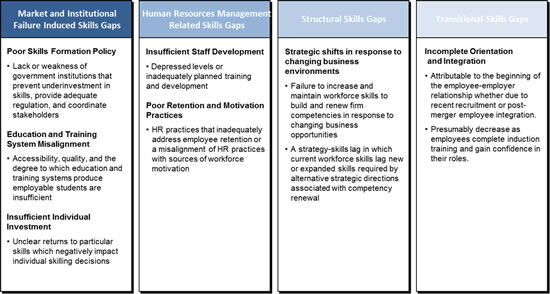A deep dive into the latest research trying to understand the source of skills gaps
- Identifying the causes of skills gaps is critically important in devising public policy interventions
- One proposition suggests skills shortages are a symptom of greater problems in the skills formation system
Given the lack of an unambiguous definition of what constitutes a skills gap in previous surveys and imperfect measurement proxies, Figure 1 below shows that the present understanding of what causes skills gaps is similarly vague. If the intent of national skills surveys is to devise public policy interventions that might affect the behavior of firms in remediating skills gaps, the precision with which the causes of skills gaps are identified is of critical importance.
Of the several skills surveys we reviewed, seven specifically ask respondents to identify the causes of skills gaps. From these surveys, four areas of thematic overlap emerge as potential causes of skills gaps: recruitment difficulties; HR practices related to employee development, motivation, and retention; strategic shifts in response to changing business environments; and transitional stages of employee orientation and integration. This section reflects briefly on these four thematic areas to advance a typology which takes into account the present understanding of the source of skills gaps.
Recruitment Difficulties: Recruitment difficulties can arise for a number of different reasons such as: competition from other employers; not enough people are interested in doing a particular job; long training times to develop skills; limited capacity of training organizations in relevant fields; poor terms and conditions offered for jobs such as unsociable hours, unattractive employment modalities, or low pay; poor prospects of career progression; location in a remote location with poor transportation; attitude, motivation, or personality mismatches etc. The multitude of reasons for recruitment difficulties requires the need to distinguish between situations where there are few people in the labor force who have the required skills, work experience, or qualifications to perform a job (a skills shortage) and situations where there are people in the labor market with the requisite skills, work experience, or qualifications but, due to some reason, are not attracted to a particular job (a recruitment difficulty).
An important consideration, however, is whether skills shortages are a symptom of greater problems involving market and institutional failures in the skills formation system rather than a direct cause of skill gaps.
Effective government institutions that prevent underinvestment in skills, provide adequate regulation, and coordinate stakeholders are key elements of effective national skills formation systems. These institutions exist to link economic development with the evolution of education and training systems; ensure qualitative and quantitative supply-demand match between outgoing students and the needs of the labor market; facilitate regular, on-the-job training provision and participation in skills formation by the business community; and address policy, informational, or financial sources of individual underinvestment in national workforce skills formation (Schwalje 2011). As governments attempt to influence the technological and industry structure of their countries, the absence or weakness of government mechanisms to coordinate and align skills formation institutions can create a need for skills that cannot be predicted by free market mechanisms which can result in skills shortages.
The effectiveness of formal education and training systems is increasingly measured by production of human capital in the quantity and quality required by the labor market and whether outgoing students meet the expectations of employers (Development 2010). Accessibility to education and training institutions, quality, and the degree to which education and training systems produce employable students influence the preparation of individuals with the skills, work experience, and qualifications to meet labor market needs.
Education and training institutions can impact allocative efficiency in labor markets which can result in skills shortages.
Private rates of return explain the motivation of individuals to pursue different levels and types of education to augment natural abilities with skills subsequently sold in the labor market. Individuals engage in an investment optimization process in which they participate in education and training as long as the value stream of future earnings is more than foregone earnings, training, and equipment expenses. However, empirical studies have shown that wage differentials relative to less skilled workers can be affected by sectoral shifts requiring higher skill intensity (Schultz 1975); when expansion of educated labor outpaces expansion in employment (Pritchett 2001); and where technological progress is rapid and government policy is conducive to technological progress and skill intensive development (Rosenzweig 2010).
Since the impacts of government industrialization policy may be unknown to individuals, information gaps about the future trajectory of industries and emergent skills needs, the returns to investing in particular skills sets, and projecting the future returns of education and training investments can result in market failure.
Skilling investments may also be subject to short-termism in which individuals are unwilling to invest in skills with uncertain and longer-term return horizons. The motivation of the labor force to engage in lifelong learning to ensure continued relevancy of skills may similarly be impacted by return uncertainties.
Capital market weaknesses in terms of a lack of funding to finance education and training investments can lead to underinvestment.
Externalities and labor market rigidities may also alter the incentives and returns to skilling resulting in sub optimal investment in skills formation. The many factors which can alter the expected return to particular skills or which signal sectoral growth or promise affect individual skilling decisions which may result in skills shortages.
Returning to the proposition that recruitment difficulties due to skills shortages are a symptom of greater problems in the skills formation system, it seems probable that skill shortages can result from market and institutional failures in the governance and institutional quality of skills formation systems, the employability of outgoing students from the education and training system, and informational or policy-related sources of uncertainty which motivate individual investment in skills development. Market and institutional failures may influence firms to engage in substitution behavior where they hire employees which they know require additional skills to meet firm needs in the face of skills shortages. Similarly, market failures and institutional quality can result in a situation where new entrants to the labor force appear to be qualified but are subsequently found to lack skills. Both of these scenarios can result in skills gaps as firms absorb employees from the external labor market who do not have the required skills, work experience, or qualifications when facing recruitment difficulties attributed to skills shortages.
Employee poaching, the tendency of firms to recruit employees with transferrable skills from other firms, and turnover may serve to limit firm-based training since training firms incur the cost of employee training only to lose the employee and resulting benefits of the training to another firm.
HR practices related to employee development, motivation, and retention: Firms provide training to increase and maintain workforce skills levels to support core competencies in addition to developing new skills that can form the basis of future firm competencies. The willingness and ability of firms to provide training and development depends on a number of factors. Managerial calculations of the returns to training may be complicated by informational gaps surrounding technology, future skill requirements, and benefits of training (Lall 1999). In situations of market or institutional failure, staff development may require training to retain competitiveness in addition to remediating inadequate pre-employment skills formation. Employee poaching, the tendency of firms to recruit employees with transferrable skills from other firms, and turnover may serve to limit firm-based training since training firms incur the cost of employee training only to lose the employee and resulting benefits of the training to another firm. Depressed levels of training and development due to a variety of factors can lead to skills gaps that erode creation and production of firm competencies jeopardizing the application of workforce skills toward market-oriented business objectives.
As mentioned in the discussion on the competence-based view of the firm, it is not enough for a firm to have a highly skilled workforce to achieve competitive advantage.
A firm’s human resources pool must also be motivated to act in the interests of the firm.
In England (30%), Scotland (7%), Northern Ireland (19%), and New Zealand (16%) many firms cite employee motivation as a cause of skills gaps (Zealand 2008; Shury, Vivian et al. 2009; Education Analytical Services 2010; Shury, Winterbotham et al. 2010). HR practices are both a way to develop workforce skills as well as to ensure alignment between workforce behavior and firm-level goals. HR practices, through their influence on employee motivation, induce productive employee behavior to apply their skills. Similarly, HR practices can affect employee turnover levels. For example, HR systems which promote employee involvement, participation, training in group problem solving, socializing, high concentrations of skilled employees, and higher average wages have been shown to reduce turnover (Arthur 1994; Delaney and Huselid 1996).
Numerous theories and metatheories of workforce motivation exist which propose various sources of motivation leading to individual behavior.
By understanding the sources of motivation, firms can design HR policies to encourage productive employee behavior which enables full deployment of workforce skills.
The most commonly researched HR policy areas which impact motivation include rewards (such as compensation and promotional systems); task (aspects of job and task design); management style; and social inducement systems (Leonard, Beauvais et al. 1999). Several studies have found that task complexity and whether a task is considered interesting or not may be more suited to certain types of motivational inducement systems (Gagne and Deci 2005). These findings suggest HR practices require tailoring to specific firm, job, and industry contexts to induce productive employee behavior. The consequence of misalignment of HR practices with sources of workforce motivation can affect employees’ choices regarding the direction, level of effort, and persistence of behavior which can lead to skills gaps.
A large percentage of employers in several countries highlight recent recruitment, post-merger employee integration, and lack of experience as causes of gaps.
Strategic shifts in response to changing business environments: The competence-based view of the firm stresses the criticality of consolidating human and other resources into market-oriented competencies that allow firms to adapt to changing environments. The ongoing renewal of competencies has implications on business processes, market positions, and expansion paths (Teece, Pisano et al. 1997). Competency renewal may involve changes in company strategy, goals, markets, business models, products and services, working practices, or technology. Evolving business strategies in response to the competency renewal process may require specialized skills that current employees lack resulting in skills gaps. Similarly, changing job requirements due, for example, to technology adoption or job promotion, might mean that once proficient employees now lack skills to perform new or evolving roles. Increasing and maintaining workforce skills in light of competency building and renewal in response to changing opportunities implies that skills gaps can emerge as firms struggle to respond to internal and external forces that threaten firm competitiveness.
Transitional stages of employee orientation and integration: A large percentage of employers in several countries highlight recent recruitment, post-merger employee integration, and lack of experience as a cause of skills gaps (Development 2006; Zealand 2008; Shury, Vivian et al. 2009; Education Analytical Services 2010; Shury, Winterbotham et al. 2010). However, it is unclear to what extent temporary, transitional phases associated with the beginning of the employee-employer relationship can be considered a cause of skills gaps since presumably such transitory skill gaps are likely to decrease as employees complete induction training and gain confidence in their roles. Generally induction training is firm specific and focused on acquainting new employees with the company structure, specific job requirements, and organization policies (Bijnens and Vanbuel 2007). A more appropriate indicator of causality would be whether an employee exhibits post-induction training persistence of a lack of skills to perform a job which results in the compromised ability of a firm to meet business objectives. Such an output indicator would then point toward an insufficient induction and integration program, rather than state of completion of the induction or integration program, as a potential source of skills gaps. Nevertheless, firms appear to view transitional stages in the employee induction process as a significant source of skills gaps.
A typology of skills gaps that considers this discussion and captures the present understanding of the source of skills gaps is shown in Figure 2 and explained below:
Market and Institutional Failure Induced Skills Gaps: These are skills gaps which stem from market and institutional failures in the skills formation system. When facing difficulty in recruiting employees from the external labor market under current market conditions due to lack of required skills, work experience, or qualifications a company demands, firms engage in substitution behavior by hiring staff who require further training. Firms may also hire new entrants to the labor market who are apparently trained and qualified for occupations but who are subsequently found to still lack a variety of the skills required. Market and Institutional Failure Induced Skills Gaps are caused by
- Poor Skills Formation Policy: Government coordination of the skills formation system fails to link economic development with the evolution of education and training systems; ensure qualitative and quantitative supply-demand match between outgoing students and the needs of the labor market; facilitate regular, on-the-job training provision and participation in skills formation by the business community; and address policy, informational, or financial sources of individual underinvestment in skills development or
- Education and Training System Misalignment: Accessibility, quality, and the degree to which education and training systems produce employable students are insufficient to prepare individuals with the skills, work experience, and qualifications to meet labor market needs or
- Insufficient Individual Investment: The many factors which can alter the expected return to particular skills or which signal sectoral growth or promise negatively impact individual skilling decisions.
Human Resources Management Related Skills Gaps: These are skills gaps which are a result of inadequate HR practices related to employee development, motivation, and retention. Human Resources Management Related Skills Gaps are caused by
- Insufficient Staff Development: Depressed levels or inadequately planned training and development that erode creation and production of firm competencies jeopardizing the application of workforce skills toward market-oriented business objectives or
- Poor Retention and Motivation Practices: HR practices that inadequately address employee retention or a misalignment of HR practices with sources of workforce motivation.
Structural Skills Gaps: These are skills gaps which are a result of strategic shifts in response to changing business environments that lead to a mismatch between current workforce skills and the requirements of employers. Structural Skills Gaps are caused by
- Strategic Shifts in Response to Changing Business Environments: Failure to increase and maintain workforce skills to build and renew firm competencies in response to changing business opportunities that may involve adjustments in company strategy, goals, markets, business models, products and services, working practices, or technology. Structural skills gaps can be viewed as a strategy-skills lag in which current workforce skills lag new or expanded skills required by alternative strategic directions associated with competency renewal. Causal ambiguity and environmental complexity makes it difficult for managers to determine the sufficiency of the current human resources pool relative to desired states of the human resources pool to achieve adapted or future business outcomes.
Transitional Skills Gaps: These are skills gaps attributable to the beginning of the employee-employer relationship whether due to recent recruitment or post-merger employee integration. Presumably transitory skill gaps are likely to decrease as employees complete induction training and gain confidence in their roles.


















































